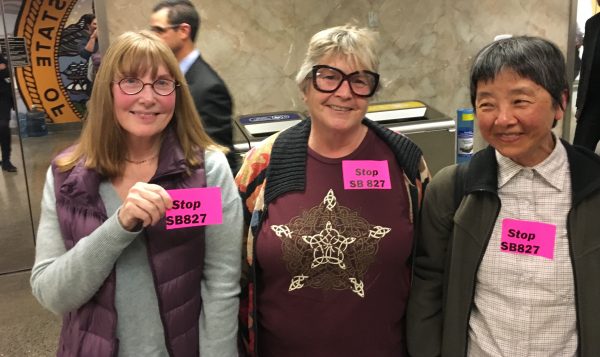Daily Business Report-Sept. 11, 2015
A Haggen grocery store before shutdown.
Grocer Haggen Files For Bankruptcy
After Failing to Win Over Shoppers
‘They were just clueless from the beginning’ — Analyst
Haggen has filed for bankruptcy protection, blaming its takeover of 146 stores from rival supermarket chain Albertsons, and plans to reorganize around its profitable locations. The West Coast regional grocer replaced its executive failing to win over shoppers, according to the Los Angeles Times.
Haggen, based in Washington state, sued Albertsons last week for damages that it said could exceed $1 billion, alleging its rival had failed to adhere to the terms of a $300 million purchase agreement for the stores it bought last year. That included six stores in San Diego County.
Albertsons, the second-largest U.S. grocer, is preparing for an initial public offering. It has said Haggen’s allegations are “without merit” and that it would fight Haggen in court.
David J. Livingston, founder of supermarket research firm DJL Research, pointed to the company’s previously small-scale operations and limited resources as poor preparation for its extensive West Coast expansion.
“They were just clueless from the very beginning,” he said. “You couldn’t do worse than what they’re doing.”
Haggen said it was forced to close 26 of the stores it acquired from Albertsons, which received antitrust approval in January for its $9.2 billion merger with Safeway.
In its Chapter 11 petition filed in U.S. Bankruptcy Court in Wilmington, Delaware, Haggen estimated it had less than $50 million in liabilities and assets of between $50 million to $100 million.
_________________________________________________________

Supreme Court Won’t Hear
Plaza de Panama Appeal
The California Supreme Court this week denied a petition by Save Our Heritage Organisation, which had sought reconsideration of an appellate court decision that upholds the legality of the Plaza de Panama project in Balboa Park.
The high court’s response — “Petition for review denied” — puts to rest any doubt that the city acted properly in approving the privately funded project to add new parkland, pedestrian-friendly plazas and parking spaces to Balboa Park, according to the City Attorney’s Office.
The roughly $45 million in park improvements would have been completed this year, in time for the park’s centennial celebration.
The Plaza de Panama project won unanimous approval from the city Planning Commission and was approved on a 7-1 vote by the City Council in 2012. The opposition group SOHO had presented a rival plan involving a network of hillside roadways and tunnels under the park.
SOHO sued on several issues including a claim that the project did not comply with a city historic resources ordinance because the city lacked a justification for replacing a historic parking lot with a pedestrian-oriented plaza. The City Attorney’s office argued that the justification included traffic engineering reports that projected Balboa Park at Plaza de Panama, absent the project, would reach Level of Service “F” traffic conditions, meaning congestion during most of the day.
The trial court judge, Judge Timothy Taylor, rejected that argument as legally insufficient and concluded that the city had failed to comply with its own historic resources ordinance. That decision was appealed.
In May, the Fourth Appellate District Court of Appeal overturned the trial judge’s decision and ruled that the City complied with its ordinance. SOHO then turned to the Supreme Court for help. But with the Supreme Court’s denial of SOHO’s petition, the final word on the project belongs to the appellate court, which wrote that the city complied with the law.
Scientists Offer Possible New
Target for Glaucoma Therapy

Scientists at the UC San Diego School of Medicine have elucidated a genetic interaction that may prove key to the development and progression of glaucoma, a blinding neurodegenerative disease that affects tens of millions of people worldwide and is a leading cause of irreversible blindness.
The findings, published in the Sept. 10 online issue of Molecular Cell, suggest a new therapeutic target for treating the eye disease.
Primary open-angle glaucoma (POAG) is the most common form of glaucoma, affecting more than 3 million Americans, primarily after the age of 50. Pressure inside the eye (known as intraocular pressure) and age are the leading risk factors for POAG, resulting in progressive degeneration of retinal ganglion cells, optic nerve damage and eventual vision loss.
Genetics also plays a role. Recent genome-wide association studies have identified two genes — SIX1-SIX6 and p16INK4a — as strongly associated with POAG. SIX6 is required for proper eye development. P16INK4a irreversibly arrests cell growth, a phenomenon called senescence.
In their new paper, principal investigator Kang Zhang, professor of ophthalmology and chief of Ophthalmic Genetics at Shiley Eye Institute at UC San Diego Health, and colleagues report that some variants of SIX6 boost expression of p16INK4a, which in turn accelerates senescence and death of retinal ganglion cells.
“We also show that high intraocular pressure in glaucoma increases expression of p16INK4a, making it a key integrator of inherent genetic and environmental risk factors that can result in glaucoma,” said Zhang.
The findings suggest that inhibiting p16INK4a could offer a new therapeutic approach for glaucoma, which is currently treated by drugs that lower intraocular pressure..
Governor Vetoes Drone Bill
Times of San Diego
Eladio Arvelo, the creator of a drone video showcasing San Diego at sunrise wanted Gov. Jerry Brown to turn lights out on legislation that would limit where he can fly. Brown did just that on Wednesday, vetoing a bill that would limit drone use over private property.
“Drone technology certainly raises novel issues that merit careful examination,” Brown wrote in his veto message. “This bill, however, while well-intentioned, could expose the occasional hobbyist and the FAA-approved commercial user alike to burdensome litigation and new causes of action.”
Said Arvelo after he learned of the veto: “I’m glad the governor realized the challenge of complying with and enforcint SB 142 and decided to veto it.”
The National Press Photographers Association also called on Brown to veto the bill.
And the 7,500-member Association for Unmanned Vehicle Systems International called SB 142 “overreaching,” and said it would “severely limit” the ability of consumer and commercial drones to take flight in the state.”
“The legislation is the wrong approach for California and the flourishing technology industry,” the group said in also urging a veto.

Prebys Cardiovascular Institute
Wins Bronze Design Award
Prebys Cardiovascular Institute, which opened in March on the campus of Scripps Memorial Hospital La Jolla, is the recipient of Modern Healthcare’s 2015 Bronze Design Award.
The 330,000-square-foot cardiovascular institute was described by one judge as having a “visually stunning exterior,” as well as a “convenient” interior whose layouts promote staff efficiency. “California is a decade ahead of everyone in requiring value,” he said.
HOK Architects of Los Angeles designed the seven-story, 167-bed hospital tower, which is named for local philanthropist Conrad Prebys, in honor of his $45 million donation.
Scripps was the lone award winner from California in Modern Healthcare’s 30th annual Design Awards. Memorial Sloan Kettering Cancer Center in West Harrison, N.Y., and St. Charles Cancer Center in Bend, Ore., won the gold and silver design awards, respectively.

North Park Mixed-Use Property
Sells fot $1,065,000
A mixed-use property on El Cajon Boulevard in North Park has been purchased by HTC Investments LLC for $1.06 million. The sellers were Emad and Sarah Mirgoli. The property is at 2029 El Cajon Blvd.
The total building area, which includes two retail storefronts and a detached duplex, is 3,756 square feet and sits on a 7,118-square-foot lot.
The sellers originally purchased the building in 2012 for $700,000. Limor Spilky, senior associate of commercial property investment sales for Location Matters Brokerage Services, represented the sellers in the transaction.

Sempra CEO Climbs
‘Most Powerful’ Ladder
Times of San Diego
For the fifth straight year, Debra L. Reed, chairman and CEO of Sempra Energy, has been named to Fortune magazine’s “Most Powerful Women in Business” list..
Reed is ranked No. 23 in 2015, up from No. 30 last year. No. 1 isMary Bara, CEO of General Motors.
“The first in her family to graduate from college, Reed became the $11-billion-in-sales energy services company’s first female CEO in 2011,” Fortune said in the profile. “Now she’s pushing to expand, planning to invest more than $19 billion over the next five years in utilities and infrastructure in the U.S., Mexico, and South America. Despite the volatility in the industry, Sempra’s stock has risen 80 percent during Reed’s tenure.”
Fortune’s “Most Powerful Women in Business” was launched in 1998 to recognize the most successful women in the nation.
In compiling the list, Fortune’s editors consider four criteria: size and importance of the woman’s business in the global economy, health and direction of the business, arc of the woman’s career, and social and cultural influence.
New Rate Structure Will Show
Up on SDG&E Bills This Month
City News Service
San Diego Gas & Electric has started a transition to a new electric rate structure, which will begin showing up on customer bills this month, the utility announced Thursday.
The structure, approved by the California Public Utilities Commission in July, has three tiers instead of the previous four. Beginning in the spring, the number of tiers will be reduced to two, according to SDG&E.
“This is the first step in providing more fairness and transparency in utility bills for all customers,” said Caroline Winn, chief energy delivery officer at SDG&E. “We want people to understand the changes to how they are billed and also how they can manage their energy costs.”
Most residential customers who pay online will receive a video link this month and next month to help them understand the changes to their bill introduced by the new rate structure. Customers can also visit www.sdge.com/ratereform to learn more about the changes still to come.
SDG&E said customers will see gradual changes to their electric bills over the next five years.
Winn said utility bills could be higher this month because of the heat.
Google Exploring 1,000-Megabit
Internet Service for San Diego
Times of San Diego
Google announced Thursday it is working with San Diego to potentially build a fiber-optic network delivering 1,000 megabit Internet speeds.
San Diego would be one of 15 cities nationwide that either have a Google Fiber network now or are in development or consideration by the company. In addition to San Diego, Google announced that Irvine in Orange County and Lousiville, KY, were under consideration.
“San Diego stood out to us,” said Jill Szuchmacher, director of expansion for Google Fiber. “It’s a community with a growing tech sector.”
She also praised city leadership for being supportive of the project and said San Diego’s diverse population was also a consideration because Google wants to bring the Internet to under-served communities.
Szuchmacher joined Mayor Kevin Faulconer and local business leaders in making the announcement under the Barrio Logan sign in a community that would significantly benefit from the project.
“It’s neighborhoods like this with a vibrant past that we must connect to the future,” said Faulconer.
The Mayor cautioned that extensive planning remains to be done before Google commits to moving forward. Szuchmacher said it would be a multi-year project requiring thousands of miles of fiber, and she declined to give a cost estimate.
Sanford Burnham Prebys Finds
Drugs That Purge Dormant HIV
Times of San Diego

A consortium of investigators led by the Sanford Burnham Prebys Medical Discovery Institute in La Jolla have found drugs that may purge dormant HIV from a patient’s body, eliminating the deadly virus once and for all.
The researchers said the drugs are already being explored in clinical trials for treating cancer, so could be approved quickly for treating HIV.
Antiretroviral therapies have made it possible for people to live with HIV for decades. However, patients continue to harbor small and persistent reservoirs of cells that hide the virus.
“If you take people off their antiretroviral therapies, some of these dormant cells reawaken to make more virus and re-establish disease,” said lead author Lars Pache, a postdoctoral fellow in the lab of Sumit Chanda, director of the immunity and pathogenesis program. “The key for a cure for HIV is to purge these cells that have dormant HIV.”
The new study, published Wednesday in the journal Cell Host & Microbe, found drugs that “tap into a molecular backdoor, a cell pathway that can be used as an intense alarm to wake up the virus, but doesn’t appear to activate the immune system,” Chanda said.
The scientists hope to partner with a pharmaceutical company to develop these drugs for evaluation in clinical models of HIV latency and then move them into human testing if they meet the safety criteria.
Personnel Announcements
Allison Simpson Joins CBRE Group Inc.

Allison Simpson has joined CBRE Group Inc. as sales director for the Occupier Advisory & Transactions Group in San Diego. Simpson will be leading the Tenant Representation Group, she will be responsible for implementing business strategies, identifying key clients and managing inbound and outbound business.
Simpson comes to CBRE from Pacific Building Group, where she was the director of business development for almost 10 years. She was responsible for new business development that focused on strategic growth and client service, and was involved with more than $10 million in new client business, generated throughout five corporate divisions in 2014.
Simpson also was the director of client relations for Perkins & Miltner LLP, a construction and real estate law firm acquired by Procopio and represented the firm as the ambassador and the face of the company.




